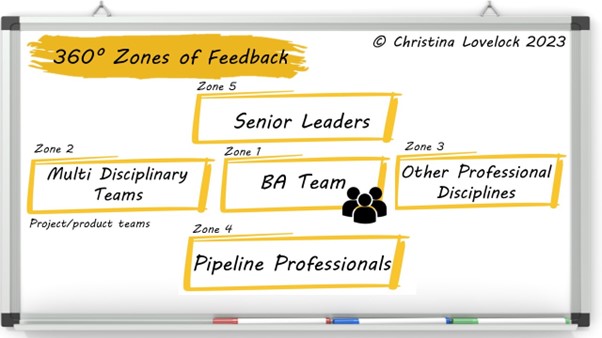
360° Feedback for BA Teams
Does your BA team actually care what other people think of the BA services provided?
Many business analysts do not consider their internal stakeholders to be ‘customers’. So when we try to understand ‘what customers think of us’ it’s common to only consider the ultimate end user of the organizations’ products or services.
Feedback
It is important for BA teams to seek regular feedback. This enables continued service improvement and growth. Knowing what our stakeholders think of our services provides both suggested improvement areas and a baseline from which improvement can be evidenced. It also helps BA leaders make the case for strategic and financial decisions, such as recruitment or investment in professional development activities.
Zones Of Feedback
Using a 360 approach allows us to consider the different groups of customers and stakeholders whose opinions matter. The perceptions of the performance and capacity of the BA team all impact the reputation, effectiveness and influence of business analysis within the organisation.
If the BA team is considered to be unresponsive or inflexible in our approach – internal customers may try to work around the BAs or actively avoid engagement. Ensuring the BA practice or team has a positive reputation is key to being engaged at the right time and being able to carry out appropriate business analysis activities.

Zone 1 – The BA Team/Practice
As with any team, its important for managers and leaders to understand if its members are happy. Do people like being a member of this team? By asking questions about wellbeing, workload and future plans, we can understand if people are happy in their BA role. This includes:
- How are we doing as a team?
- What could we do that would make your role easier?
- What can we learn from other places you have worked?
- Are you hoping to progress within the organization within the next 18 months?
- Is your workload manageable?
When team members feel that they are supported and appreciated, they are much more likely to perform well in their role, and stay longer within their organization.
This should be one of the zones from which feedback is sought most frequently. This can be a combination of anonymous quantitative feedback (quick polls, pulse surveys etc.) to inform simple metrics and more detailed qualitative feedback based on conversations to allow a deeper understanding of views.
Advertisement
Zone 2 – Multi Disciplinary Teams
These are the teams which individual BAs contribute to. This might be project or delivery teams brought together for a fixed time period, or product teams with ongoing responsibilities for product development and maintenance. It is useful to understand the experience and perspective of the customers who work with business analysts day-to-day. Do these close colleagues understand and value the contribution made by business analysts to the team?
Feedback should be sought at sensible times, such as delivery milestones, when a BA leaves an assignment/team, or as in input to structured performance review cycles.
Where projects/stakeholders continually request the same business analyst(s), it suggests a lack of faith in the BA team and a reliance on the skills/knowledge of an individual. If that is the case, how can the BA team share knowledge and skills and improve consistency of the BA services delivered?
It’s also worth considering if feedback received is actually about BA capacity (being over loaded/ too stretched) rather than capability, and how that issue could be addressed.
Zone 3 – Other Professional Disciplines
This zone includes all the related and adjacent professional disciplines within the organisation, who the business analysts sometimes interact with. This includes business functions such as HR, finance, marketing, compliance, business teams and subject matter experts. Often they don’t form part of multi-disciplinary delivery teams, but BAs may often interact and engage with them. Its useful to understand the reputation of BAs amongst project managers, product owners and developers – even ones who don’t regularly interact with BAs. How likely would they be to spot the need for business analysis activities and seek out a BA?
Zone 4 – Pipeline Professionals
This is the potential talent pipeline into business analysis from elsewhere in the organization. Roles such as IT helpdesk, call center operatives and front line business teams. Do they know business analysis exists within the organization? Do they aspire to become BAs? Are there routes for them to follow? Do we provide opportunities to share our skills and knowledge to make business analysis visible, accessible and desirable? In a competitive recruitment market and for a competitive advantage, we cannot afford to ignore internal development routes into business analysis.
Zone 5 – Senior Leaders
This zone includes all senior leaders and decision makers. Not just whichever executive has reporting line responsibility for business analysis, but all influential leaders. The skillset of business analysts has a huge amount to offer those in leadership positions: BAs are objective critical thinkers, able to identify and define problems and investigate feasible solutions. Few zones of the organization need access to these skills more than the leadership team!
Do they know how business analysts offer value? Do they know how to get BAs involved? Are they factoring business analysis time and resources into their strategic plans and estimates? Do they genuinely want more evidence based decision making? If so, they need more business analysis!
It’s hard to get the time and attention of these leaders, but for us to help them (and the organization, to the best of our ability), they need to know we exist.
External Stakeholders
Any of these zone could also extend to cover external stakeholders, such as third party suppliers, partners, regulators, and external clients. While it may not be possible to engage in formal feedback processes due to organizational relationships, it is still possible to seek appropriate informal feedback to strengthen relationships, understand expectations and ultimately improve results.
Methods Of Obtaining Feedback
A variety of different approaches can be used, and this needs to take into account the culture of the organization and the expectations of different groups.
Consider a mix of:
- Informal catch-ups over coffee
- Email requests
- Online surveys/ system
- Formal recognition and review processes.
“We haven’t done it before” and “no one else does it” are not good reasons to avoid seeking feedback!
Conclusion
By thinking about these zones of stakeholders it is possible for the BA team to get a 360° picture of our performance, perception and reputation. If we don’t like the feedback, or don’t feel it reflects reality – then what action does that prompt? We can’t change opinions for the positive, if we are too scared to ask about current perceptions.
If BA teams can be brave and lead the way on establishing a 360 feedback culture, it will lead to better results and better relationships in the long run. It will also normalize the giving and receiving of feedback, which is a key contributor to high performing teams.